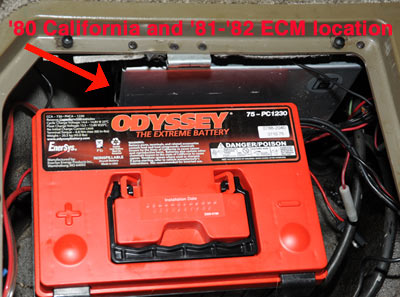Orphaned, Bastardized but Certainly Historic: The Strange Case of the 1980 California Corvettes
© 2010 by Hib Halverson
No use without permission, All Rights Reserved

In 1980 California cars and '81s and '82s, the ECM is on the front bulkhead of the well behind the driver seat.
Image: Author
Set the Wayback Machine for late-1970s. For the coming 1980 model year, Chevrolet was facing exhaust emissions regulations more stringent in California than in other states and those new standards were going national in '81. These laws drove a major effort at Chevy Engineering to perfect digital electronic engine controls as a way to maintain drivability while meeting those requirements.
So it could sell 1980 Vettes in the "Demokratik People's Republik of Kalifornia" and to gain field experience with engine electronics, the Bow-Tie guys decided a dress rehearsal for their budding technology would be a new, 5.0-liter V8 (RPO LG4) installed in all Corvettes sold in California. This engine was fitted with a system called "Computer Controlled Catalytic Converter" or "C-4".
Even these early digital controls had a positive effect on performance, drivability and emissions. LG4s made only 10hp less than the 50-cubic-inch-larger, non-computer, 5.7-liter L48, the base powerplant in the other 49 states, but had lower emissions and better drivability. LG4 earned the buyer a $50 credit and all 3221 of these cars had automatic transmissions. They're identified by the letter "H" in their VINs, a "ZCA" block code, an oxygen sensor in the driver-side exhaust manifold and a QuadraJet carburetor having electronically-controlled idle and primary main circuits. Though C-4 helped with emissions and drivability, it had a nasty downside which made diagnosis tough.
The system was slow. We figure, back then, engineers used sun dials to benchmark processor speed-well, maybe not that bad, but it was slow. In some cases, a problem would have to exist as long as five minutes before a DTC set. This slowness made many problems intermittents which, in later years, would be hard codes.
Once a DTC set, there was another problem: '80 ECMs had "volatile" memory, ie: turn off the ignition and the memory was cleared. If a DTC was set, you had to read it before clicking off the key. Interestingly, one could make the memory permanent by putting battery voltage to an orange wire that runs from the ECM's S-terminal. This procedure is discussed in the 1980 Corvette Service Manual; however, illustrations showing the location of the wires are incorrect. The orange wire is near the ECM and the battery, behind the driver seat. Connect this wire to the positive battery post and the ECM memory becomes permanent. Did this bizarre situation exist due to Chevrolet's fear that the memory would drain the battery? Who knows.
If you get the "Check Engine" light in an '80 California car, make the orange wire connection during the diagnosis period. If battery condition is an issue; buy a trickle charger. You're better off with the permanent memory when trying to solve a problem.
The biggest bastardization of all, however, was these ECMs did not transmit serial data, so as far as a scan tester goes; '80 California cars are orphans. Intermittents, of which there are many because of the system's slowness, are far more difficult to solve. You'll need a good DMM with a recording feature, such as the Fluke 88V which we'll cover in Pt 3 of this series, and the troubleshooting charts in the 1980 Corvette Service Manual-plenty of patience, too.
Thankfully, at least, you can use flash code diagnostics to read codes from the LG4 ECMs when the its "diagnostic ground" or "trouble code" test lead is grounded. It's a white-and-black wire wire tipped with a green connector near the ECM. Run a jumper from the green connector to ground, start the engine when read the codes as discussed elsewhere.
The section on C-4 in the 1980 Corvette Service Manual is a reprint of material in books for other cars. There are no Corvette component locators or wiring diagram. In spite of those limitations, for what information that does exist; the factory manual is the only place to find it.
We don't envy people working on '80 C-4 cars, especially those trying to solve intermittents, however, the system was a milestone. Besides enabling Corvettes to meet California emissions, the five-liter, LG4 provided valuable knowledge that helped GM better the engine controls used in later years.
C-4 was a one-year system on Corvette. For 1981, all cars had the new, L81 350, equipped with a refined system called "Computer Command Control" which had a nonvolatile memory and could transmit serial data to a scan tester.
